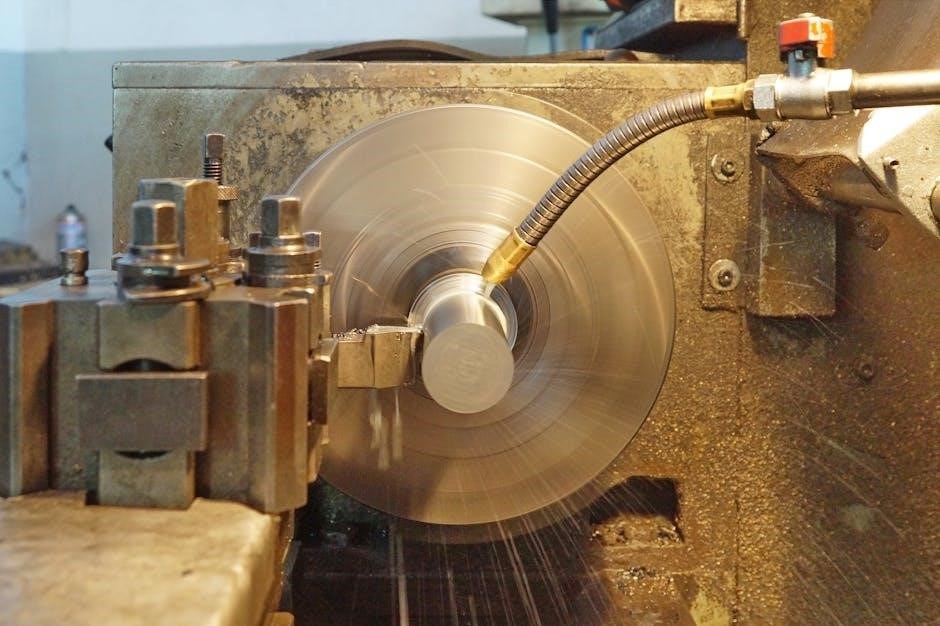Lathe cutting speed charts are essential guides for optimizing machining processes, providing detailed recommendations for cutting speeds, feed rates, and depths of cut based on material and tool types.
1.1 Definition and Purpose of Cutting Speed Charts
Lathe cutting speed charts are graphical tools that define the optimal machining parameters for various materials and tools. They illustrate the relationship between cutting speed, feed rate, and depth of cut, ensuring efficient material removal while maintaining tool longevity. These charts serve as a reference guide to help machinists select appropriate speeds and feeds for different operations, preventing tool breakage and improving surface finish. By standardizing machining parameters, they aim to enhance productivity, reduce costs, and ensure consistent results across manufacturing processes.
1.2 Importance of Cutting Speed Charts in Machining
Lathe cutting speed charts are crucial for ensuring optimal machining performance. They prevent tool breakage by providing appropriate speed and feed recommendations, reducing downtime and maintenance costs. By optimizing cutting parameters, these charts improve surface finish, enhance material removal rates, and extend tool longevity. They also standardize machining processes, reducing variability and ensuring consistent results. Additionally, they help machinists avoid excessive heat generation, which can damage tools and workpieces. Overall, cutting speed charts are indispensable for achieving efficient, precise, and cost-effective machining operations across various materials and applications.

Understanding the Lathe Cutting Speed Chart
A lathe cutting speed chart graphically represents relationships between cutting speed, feed rate, depth of cut, and material properties to optimize machining processes efficiently.
2.1 Key Parameters: Cutting Speed, Feed Rate, and Depth of Cut
Cutting speed, feed rate, and depth of cut are fundamental parameters in machining. Cutting speed, measured in meters per minute or feet per minute, determines how fast the tool moves along the workpiece. Feed rate, often in millimeters per revolution or inches per revolution, specifies how much material is removed with each tool pass. Depth of cut, measured in millimeters or inches, indicates how deeply the tool penetrates the material. Balancing these parameters is crucial for achieving optimal machining results, ensuring efficiency, and maintaining tool longevity. Proper settings prevent tool wear and breakage, while also improving surface finish and material removal rates.
2.2 Graphical Representation of Machining Parameters
Lathe cutting speed charts often use graphical representations, such as color-coded tables or interactive charts, to illustrate the relationship between machining parameters. These visuals simplify the process of identifying optimal cutting speeds, feed rates, and depths of cut for specific materials and tools. By organizing data in a visually accessible format, machinists can quickly reference and adjust settings to achieve desired outcomes, such as maximizing material removal rates or ensuring tool longevity. This graphical approach enhances understanding and application of machining parameters, making it easier to optimize processes for efficiency and precision.

Factors Influencing Cutting Speed
Material properties, such as hardness and toughness, significantly influence cutting speeds, as harder materials require lower speeds to prevent tool wear and ensure efficient machining.
3.1 Material Properties (Hardness, Toughness, etc.)

Material properties, such as hardness and toughness, significantly influence cutting speeds. Harder materials require lower cutting speeds to prevent tool wear and breakage, while softer materials allow higher speeds. Toughness also plays a role, as tougher materials may require adjustments in feed rates and depths of cut to maintain optimal machining efficiency. Understanding these properties is crucial for selecting appropriate parameters from lathe cutting speed charts, ensuring prolonged tool life and achieving desired surface finishes. Proper consideration of material characteristics helps balance productivity and tool longevity in machining operations.
3.2 Tool Material and Geometry
Tool material and geometry significantly impact cutting speeds and tool life. High-speed steel (HSS) tools are suitable for softer materials, while carbide tools excel with harder materials due to their durability. The geometry of the tool, including cutting edge angles and chip formation, affects machining efficiency and surface finish. Proper tool selection based on material properties ensures optimal performance. The interplay between tool material and geometry determines the recommended cutting parameters in lathe cutting speed charts, balancing material removal rates with tool longevity. This ensures efficient and precise machining operations across various applications.
3.3 Machining Operations (Turning, Drilling, Milling)
Machining operations like turning, drilling, and milling require specific cutting parameters. Turning involves rotating the workpiece, while drilling and milling use stationary tools. Each operation demands unique cutting speeds and feeds to ensure efficiency and accuracy. For instance, turning often uses higher speeds but lower feeds, whereas milling may require lower speeds with higher feeds. The lathe cutting speed chart provides tailored recommendations for each operation, ensuring optimal material removal rates and tool life. By adhering to these guidelines, machinists can achieve precise results and extend tool longevity across various machining tasks.
How to Read a Lathe Cutting Speed Chart
A lathe cutting speed chart graphically represents cutting speed, feed rate, and depth of cut based on material properties and tool types, enabling optimal cutting conditions and improved machining efficiency while minimizing tool wear.
4.1 Identifying Material and Tool Combinations
Material and tool combinations are crucial for selecting the right cutting parameters. Charts categorize materials by hardness, such as steel, aluminum, and plastics, and pair them with suitable tools like high-speed steel or carbide. Each combination has specific cutting speeds and feeds, ensuring optimal performance. For instance, hardened steel requires lower speeds to prevent tool breakage, while aluminum can tolerate higher speeds due to its softer nature. Proper identification ensures efficient machining, improving surface finish and tool longevity, and is a foundational step in using cutting speed charts effectively.
4.2 Interpreting Speeds and Feeds for Specific Operations
Lathe cutting speed charts provide specific guidelines for interpreting speeds and feeds based on the operation type, such as roughing or finishing. For roughing cuts, higher feed rates are recommended to maximize material removal, while finishing cuts require lower feeds to achieve a smoother surface finish. The charts also consider tool material and geometry, ensuring optimal performance. By adjusting speeds and feeds according to the operation, machinists can balance productivity, tool longevity, and part quality, ensuring efficient and precise machining processes.

Practical Applications of the Chart
Lathe cutting speed charts enable machinists to determine optimal cutting speeds for various materials, adjust feed rates for roughing and finishing, and improve overall machining efficiency and cost-effectiveness.
5.1 Determining Optimal Cutting Speeds for Different Materials
Lathe cutting speed charts provide a detailed lookup table for determining optimal cutting speeds based on material type and tool used. Harder materials like hardened steel require lower speeds to prevent tool breakage, while softer materials such as aluminum can withstand higher speeds. By referencing the chart, machinists can identify the ideal balance between material removal rates and tool longevity, ensuring efficient and precise machining. This ensures optimal performance across various materials, reducing downtime and improving overall productivity in manufacturing processes.
5.2 Adjusting Feed Rates for Roughing and Finishing Cuts
Adjusting feed rates is crucial for optimizing machining processes. For roughing cuts, higher feed rates are applied to maximize material removal, while finishing cuts require lower feed rates to achieve a smooth surface finish. The lathe cutting speed chart provides specific recommendations for feed rates based on material properties and tool types. Proper adjustment ensures reduced tool wear, improved surface quality, and increased efficiency. By tailoring feed rates to the specific operation, machinists can balance productivity and precision, ensuring optimal results for both roughing and finishing applications.

Optimizing Machining Processes
Optimizing machining processes involves maximizing material removal rates while improving surface finish and tool longevity. High-speed machining and advanced tool materials are key to achieving these goals efficiently.
6.1 Maximizing Material Removal Rates (MRR)
Maximizing material removal rates (MRR) is critical for improving productivity in machining. Higher cutting speeds and feed rates can significantly increase MRR, but they must be balanced with tool longevity. Modern tool materials, such as carbide and high-speed steel, enable faster operations without compromising tool life. Proper chip load management ensures efficient cutting, preventing overheating and tool wear. Machinists can reference lathe cutting speed charts to identify optimal parameters for specific materials, ensuring high MRR while maintaining surface quality and extending tool lifespan. This balance is key to achieving efficient and cost-effective machining processes.
6.2 Improving Surface Finish and Tool Life
Improving surface finish and tool life requires careful optimization of cutting parameters. Proper chip load management prevents overheating, ensuring a smooth finish and reducing tool wear. Lower cutting speeds and lighter feed rates are often necessary for finishing cuts to achieve precise surface quality. Tool geometry and material selection also play a critical role, with modern coatings and carbide tools offering enhanced durability. By adhering to recommended parameters from cutting speed charts, machinists can balance productivity with part quality, extending tool lifespan and reducing operational costs. This ensures efficient and precise machining outcomes consistently.

Common Challenges in Using Cutting Speed Charts
Challenges include selecting the right parameters for unknown materials, balancing chip load, and avoiding tool wear. Proper adjustments ensure optimal machining without compromising surface quality or tool longevity.
7.1 Selecting the Right Parameters for Unknown Materials
Selecting the right parameters for unknown materials is challenging due to varying hardness, toughness, and thermal properties. Start with conservative cutting speeds and feed rates, adjusting based on chip color and tool wear. Monitor material behavior, as harder materials require lower speeds to prevent tool breakage. Use reference charts as a baseline but be prepared to fine-tune settings. Proper parameter selection balances material removal rates with tool longevity, ensuring efficient machining without compromising surface finish or tool life. Documentation of outcomes aids future adjustments for similar unknown materials.
7.2 Avoiding Tool Wear and Breakage
Avoiding tool wear and breakage requires careful consideration of cutting speeds, feed rates, and material properties. Excessive heat generated by high cutting speeds can accelerate tool wear, while improper chip formation may lead to tool breakage. Using the right tool material, such as high-speed steel or carbide, is crucial for specific applications. Monitoring cutting conditions and adjusting parameters ensures optimal performance. Proper chip load and depth of cut also play a key role in extending tool life and preventing premature failure. Regular tool inspections and timely adjustments are essential for maintaining efficiency and reducing downtime in machining operations.

Advanced Strategies for High-Speed Machining
Advanced strategies involve optimizing cutting parameters, using modern tool materials, and implementing dynamic speed adjustments for high-efficiency machining while maintaining tool longevity and surface finish quality.
8.1 High-Speed Turning and Milling Techniques
High-speed turning and milling techniques focus on maximizing efficiency while maintaining precision. These methods often involve advanced tool materials, such as carbide or coated tools, to withstand high cutting speeds. By optimizing feed rates and depths of cut, machinists can achieve faster material removal rates (MRR) without compromising tool life. Techniques like ProfitTurning emphasize rapid roughing and finishing, reducing cycle times significantly. Proper spindle speed adjustments ensure optimal performance across various materials, from hardened steels to aluminum alloys.
Live lathe tools with gear boxes (e.g., 5:1 or 1:5 ratios) enable high-torque and high-speed operations, improving surface finish and reducing vibrations. These strategies are particularly effective in modern CNC machining, where dynamic speed adjustments and precise parameter control are essential for high-quality outcomes.
8.2 Using Modern Tool Materials for High-Speed Applications
Modern tool materials, such as carbide and advanced coated tools, are designed to withstand the demands of high-speed machining. These materials offer superior hardness, thermal stability, and wear resistance, enabling faster cutting speeds and extended tool life. Coatings like TiN and TiAlN reduce friction and prevent thermal deformation, while high-speed steel (HSS) tools remain cost-effective for lighter operations. Proper selection of tool materials ensures optimal performance in high-speed turning and milling, minimizing downtime and improving part quality. Advanced tool geometries further enhance machining efficiency at elevated speeds.

Case Studies and Examples
Case studies demonstrate optimal machining of hardened steel and aluminum alloys, showcasing how cutting speed charts ensure high material removal rates and improved surface finishes.
9.1 Machining Hardened Steel at Optimal Speeds
A case study on machining hardened steel (AISI 5153) demonstrates the effectiveness of lathe cutting speed charts. Cutting speeds of 250 m/min with carbide tools achieved high material removal rates while maintaining tool life. The optimal parameters ensured minimal wear and consistent surface finish, proving the chart’s reliability in high-speed turning applications. This example highlights how adhering to recommended speeds enhances productivity and reduces tooling costs in industrial machining processes.
9.2 High-Speed Turning of Aluminum Alloys
A case study on high-speed turning of aluminum alloys (e.g., 6061-T6) using carbide tools demonstrates the chart’s practicality. Cutting speeds reached 13260 RPM (250 m/min), achieving high material removal rates and excellent surface finish. Feed rates were optimized to balance tool life and productivity. This example showcases how the lathe cutting speed chart enables machinists to select ideal parameters, ensuring efficient and precise machining of lightweight materials commonly used in aerospace and automotive industries.

Troubleshooting Common Machining Issues
Lathe cutting speed charts help diagnose issues like tool wear or poor surface finish by identifying incorrect speeds or feeds, enabling precise adjustments for improved machining outcomes.
10.1 Diagnosing Issues Based on Cutting Speed and Feed
Diagnosing machining issues often involves analyzing cutting speeds and feed rates. Improper settings can lead to tool wear, poor surface finish, or uneven material removal. By consulting the lathe cutting speed chart, machinists can identify if speeds are too high, causing excessive heat and tool degradation, or too low, resulting in inefficient cutting. Feed rates that are too aggressive may cause vibration or deflection, while insufficient feeds can lead to incomplete material removal. Adjusting these parameters based on the chart ensures optimal performance and minimizes operational setbacks, enhancing overall machining accuracy and efficiency. Material properties and tool geometry also play a critical role in diagnosing and resolving these issues.
10.2 Adjusting Parameters for Improved Results
Adjusting cutting parameters is crucial for achieving desired machining outcomes. By optimizing feed rates and spindle speeds, machinists can enhance surface finish and tool longevity. Material properties and tool geometries significantly influence these adjustments. For instance, harder materials may require lower speeds to prevent tool wear, while softer materials can tolerate higher rates for efficiency. Consulting the lathe cutting speed chart ensures precise recommendations, balancing material removal rates with tool durability. Fine-tuning these settings often resolves issues like vibration or uneven cuts, leading to improved productivity and component quality.
Future Trends in Cutting Speed Charts
Future trends include integration of cutting speed charts with CNC machining and automation. Dynamic charts will optimize parameters for complex materials, enhancing precision and efficiency in modern machining.
11;1 Integration with CNC Machining and Automation
Integration of lathe cutting speed charts with CNC machining and automation enhances precision and efficiency. CNC systems utilize real-time data from these charts to optimize cutting parameters, ensuring consistent results. Automated adjustments based on material properties and tool geometry minimize human error; This integration enables seamless implementation of recommended speeds and feeds, reducing downtime and improving productivity. Advanced CNC software can interpret dynamic charts, adapting to complex materials and operations. As automation advances, the role of cutting speed charts evolves, becoming integral to intelligent machining systems.
11.2 Development of Dynamic Speed Charts for Complex Materials
Dynamic speed charts are being developed to address the challenges of machining complex materials like high-strength alloys and composites. These charts adapt in real-time, adjusting speeds and feeds based on material behavior and tool wear. Sensors embedded in CNC machines gather data on cutting forces and temperatures, enabling precise adjustments. This technology ensures optimal performance for diverse materials, reducing trial-and-error processes. Dynamic charts also incorporate AI algorithms to predict optimal parameters, enhancing efficiency and tool longevity. This advancement is crucial for modern industries requiring precision and adaptability in machining operations.
Lathe cutting speed charts are indispensable references for achieving optimal machining results. They guide machinists in selecting the right parameters, ensuring efficiency, precision, and tool longevity. As machining evolves, these charts remain vital for modern manufacturing, adapting to new materials and technologies while maintaining their core purpose of enhancing productivity and quality.
12.1 Summary of Key Takeaways
Lathe cutting speed charts are essential tools for optimizing machining processes, providing critical data on cutting speeds, feed rates, and depths of cut. They help machinists select appropriate parameters for various materials and tools, ensuring efficient material removal and extended tool life. By adhering to these charts, manufacturers can achieve higher productivity, improved surface finishes, and reduced operational costs. Additionally, understanding the relationship between these parameters enables better decision-making, leading to enhanced machining outcomes and adaptability to evolving technologies and materials.
12.2 The Evolving Role of Cutting Speed Charts in Modern Machining
Lathe cutting speed charts are adapting to advancements in machining, integrating with CNC systems and automation for precise control. Dynamic charts now address complex materials and high-speed applications, offering real-time adjustments. Modern tools, like carbide and coated inserts, enable faster operations without compromising longevity. These innovations ensure charts remain vital, enhancing productivity and precision while addressing future challenges in machining. Their evolution underscores their enduring relevance in optimizing processes for both traditional and cutting-edge manufacturing needs.



